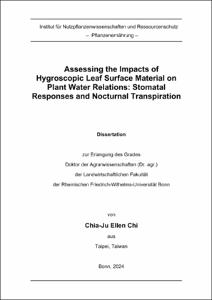Chi, Chia-Ju Ellen: Assessing the Impacts of Hygroscopic Leaf Surface Material on Plant Water Relations: Stomatal Responses and Nocturnal Transpiration. - Bonn, 2024. - Dissertation, Rheinische Friedrich-Wilhelms-Universität Bonn.
Online-Ausgabe in bonndoc: https://nbn-resolving.org/urn:nbn:de:hbz:5-75757
Online-Ausgabe in bonndoc: https://nbn-resolving.org/urn:nbn:de:hbz:5-75757
@phdthesis{handle:20.500.11811/11494,
urn: https://nbn-resolving.org/urn:nbn:de:hbz:5-75757,
doi: https://doi.org/10.48565/bonndoc-266,
author = {{Chia-Ju Ellen Chi}},
title = {Assessing the Impacts of Hygroscopic Leaf Surface Material on Plant Water Relations: Stomatal Responses and Nocturnal Transpiration},
school = {Rheinische Friedrich-Wilhelms-Universität Bonn},
year = 2024,
month = apr,
note = {The increase in atmospheric aerosols from human activities like industry and agriculture has raised concerns about their impact on plant physiology, particularly due to their hygroscopic nature. While past research focused on aerosols' indirect effects on photosynthesis, recent studies delve into their direct effects on plant foliage. This study examines hygroscopic leaf surface material primarily from aerosol deposition or agricultural sprays. These compounds can form concentrated solutions on leaf surfaces, affecting water potential and vapor pressure deficit (VPD), and facilitating bidirectional stomatal transport.
This doctoral research investigates the comprehensive effects of hygroscopic material on plant physiology and water relations, emphasizing stomatal responses and nocturnal transpiration. Experiments conducted on poplar clones and camphor seedlings in varying aerosol environments reveal that hygroscopic material forms crusts on leaf surfaces, potentially exacerbating plant water deficit. The effects on stomatal responses vary between plants with different water use strategies. Anisohydric plants are more sensitive to the hygroscopic material (i.e., aerosols), while isohydric plants are more sensitive to atmospheric conditions (i.e., VPD changes). Additionally, nocturnal transpiration experiments indicate a bidirectional pathway for hygroscopic material uptake by plants, suggesting a trade-off between water loss and nutrient uptake through leaves.
Overall, this study supports the Hydraulic Activation of Stomata (HAS) theory and its influence on plant water and nutrient relations, highlighting the species-specific and environment-specific nature of these effects.},
url = {https://hdl.handle.net/20.500.11811/11494}
}
urn: https://nbn-resolving.org/urn:nbn:de:hbz:5-75757,
doi: https://doi.org/10.48565/bonndoc-266,
author = {{Chia-Ju Ellen Chi}},
title = {Assessing the Impacts of Hygroscopic Leaf Surface Material on Plant Water Relations: Stomatal Responses and Nocturnal Transpiration},
school = {Rheinische Friedrich-Wilhelms-Universität Bonn},
year = 2024,
month = apr,
note = {The increase in atmospheric aerosols from human activities like industry and agriculture has raised concerns about their impact on plant physiology, particularly due to their hygroscopic nature. While past research focused on aerosols' indirect effects on photosynthesis, recent studies delve into their direct effects on plant foliage. This study examines hygroscopic leaf surface material primarily from aerosol deposition or agricultural sprays. These compounds can form concentrated solutions on leaf surfaces, affecting water potential and vapor pressure deficit (VPD), and facilitating bidirectional stomatal transport.
This doctoral research investigates the comprehensive effects of hygroscopic material on plant physiology and water relations, emphasizing stomatal responses and nocturnal transpiration. Experiments conducted on poplar clones and camphor seedlings in varying aerosol environments reveal that hygroscopic material forms crusts on leaf surfaces, potentially exacerbating plant water deficit. The effects on stomatal responses vary between plants with different water use strategies. Anisohydric plants are more sensitive to the hygroscopic material (i.e., aerosols), while isohydric plants are more sensitive to atmospheric conditions (i.e., VPD changes). Additionally, nocturnal transpiration experiments indicate a bidirectional pathway for hygroscopic material uptake by plants, suggesting a trade-off between water loss and nutrient uptake through leaves.
Overall, this study supports the Hydraulic Activation of Stomata (HAS) theory and its influence on plant water and nutrient relations, highlighting the species-specific and environment-specific nature of these effects.},
url = {https://hdl.handle.net/20.500.11811/11494}
}






